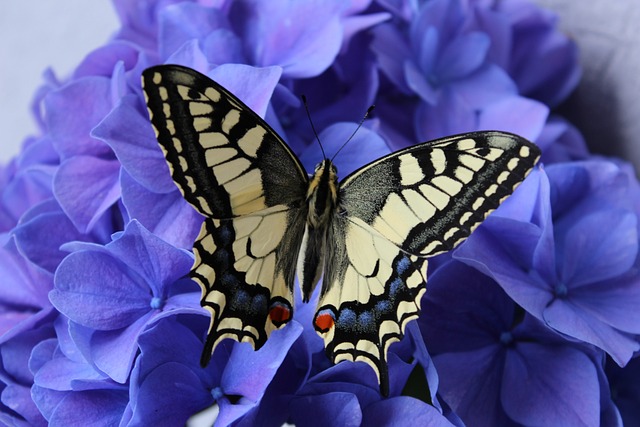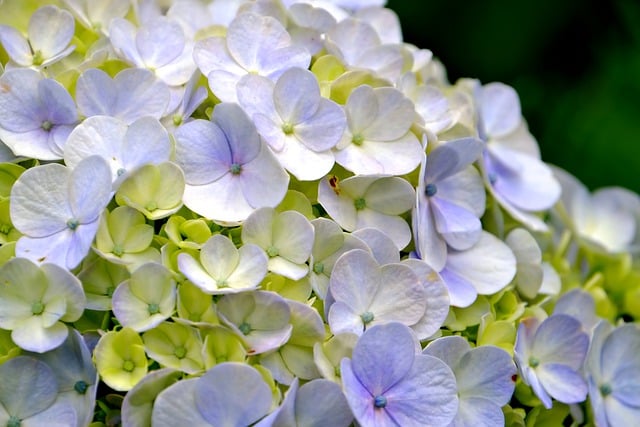Low-maintenance shrubs cultivated for their large, exquisite blooms are hydrangeas. However, their size has prevented them from being used in smaller gardens. Huge hydrangeas can choke out smaller plants in their vicinity. Plant breeders have been busy developing tiny hydrangea cultivars that yet produce amazing blooms.

With most dwarf or petite hydrangea cultivars reaching a maximum height of three or four feet or less, they may easily fit into places that are more constrained. Use them as low hedges or foundation plants, or put them in pots on a patio, porch, or balcony. When included in a perennial border or placed in the forefront of a mixed shrub border, these little hydrangeas provide continuous blooms for many months.
Hydrangeas come in a variety of forms, such as bigleaf, panicle, and oakleaf. Whichever kind you want, there are tiny variations available. Each has distinct qualities. These are eighteen amazing choices.
Small-Bolled Hydrangeas
Bigleaf hydrangeas (Hydrangea macrophylla) feature large leaves, as its name suggests. They also yield big blooms, which might be delicate-looking lacecaps or mopheads shaped like balls. The pH of the soil typically determines the color of the flowers; pink flowers grow in an alkaline soil, whereas blue or purple blooms are produced in an acidic environment. Morning light is ideal for these hydrangeas, with some midday shadow. They thrive in Zones 5 through 9.
Reblooming mophead hydrangea ‘Mini Penny’ blooms all summer long until the first frost. The pH of the soil determines whether the blossoms are pink or blue. It grows to be approximately three feet tall and three to four feet broad, with a mounding habit. It has a high resistance to illness.
Another name for “Pistachio” (shown above) is “Horwack.” It produces clusters of multicolored mophead flowers that start out chartreuse-green but eventually become vivid pinkish red or violet with centers that are pale blue and some chartreuse accents. From late spring until fall, there is a continuous display of vibrant flowers since they bloom on both old and young wood. It reaches heights of 2 to 3 feet and widths of 3 to 5 feet.
“Venice Raven” is a dwarf and petite hydrangea variety of the German-bred Cityline Series, sometimes marketed as Cityline Venice. Depending on the pH of the soil, the mophead flower clusters, which bloom on old wood from mid- to late summer, may reach a diameter of 6 inches and are either pink or blue in color. The plant may reach a height and width of three feet, with a compact growth habit.
Part of the Let’s Dance series, “Rhythmic Blue” was developed to survive colder winters. Because it is a rebloomer, blossoms will still emerge on new growth even if stems die to the ground. This hydrangea produces rich, genuine blue blooms in acidic soil, while its mophead blossoms are brilliant pink in alkaline soil. When fully grown, it stands 3 to 4 feet tall and broad.
A new variety of Endless Summer hydrangeas, “Endless Summer Pop Star,” is also bred for areas with cooler winters. It bears flowers till the first frost and blooms sooner than other kinds. In acidic soil, the lacecap flowers are electric blue, whereas in alkaline soil, they are brilliant pink. It spreads out to a width of around 3 feet.
Little Hydrangeas with a Mountain Aura
The mountain hydrangea, or Hydrangea serrata, is a native of Japan and Korea’s forests. It resembles bigleaf hydrangea, but with smaller, more delicate leaves and blooms. Like bigleaf hydrangeas, it usually produces lacecaps, which are long-lasting flowers whose color is influenced by the pH of the soil. It is hardy in Zones 5 to 9, and grows best in mild, open shade.
The little hydrangea known as “Tuff Stuff” (shown above) blooms lavender-blue in acidic soil and pink with creamy centers when grown in alkaline soil. It is a rebloomer that produces fresh blooms all summer long. In the autumn, its serrated leaves turn crimson.
When mature, it will stand three feet tall and have a comparable spread. It is ideal for massing in front of trees or shrubs that are higher.
Similar to “Tuff Stuff,” “Tiny Tuff Stuff” blooms flowers on diminutive hydrangea plants that are no more than two feet in height and width. It’s a fantastic option for front boundary garden additions or container gardening.

Small Pendant Hydrangeas
Although it is native to Asia as well, this species thrives in Zones 3–8, being more resilient than other hydrangeas. Panacole hydrangeas, or Hydrangea paniculata, are enormous bushes that may grow up to 20 feet tall and 12 feet wide in the wild. From July until the first frost, they produce huge clusters, or panicles, of white flowers on fresh growth. Soil pH has little effect on blossom color; they typically become pink when the temperature cools. They thrive in full to partial sunlight.
Compared to other species, “Bombshell” has a more rounded, creamy white flower panicle and a highly compact habit. Blossoms are prevented from drooping on the plant by strong, rigid stalks, and as they become older, they often take on pink tones. Both fresh and dried, they create beautiful little hydrangea blossoms for cutting. When fully grown, this little hydrangea will be 2 to 3 feet tall and 3 to 4 feet wide, with a thick, mounding habit.
Another incredible bloomer is “Bobo,” who is seen above. On robust stems, it bears huge, cone-shaped panicles of white flowers that mature to pink or light purple. The plant might seem to be completely covered in blossoms from midsummer till winter. It has an erect, mounded habit and develops to be 2 to 3 feet tall and 3 to 4 feet broad.
On a smaller shrub, “Firelight Tidbit” has the same panicles of white flowers. Its blooms resemble those of ‘Bobo,’ but as it ages, they change from brilliant pink to red. This little shrub, which grows 2 to 3 feet tall and wide, looks well in pots or in perennial borders.
“Flare” is rounded-tailed and produces panicles that are 6 to 10 inches long and borne erect on stems. When the air cools in the autumn, the blossoms change from being white to a very vivid pink. They then become reddish pink. It grows 2 to 3 feet tall and broad, and it can withstand both heat and cold.
Little Hydrangeas with a Smooth Texture
Native to eastern North America, Hydrangea arborescens is a smooth hydrangea. It is a multistemmed, erect shrub with an open, loose branching habit. Late spring to summer sees the flattened clusters of greenish-white, 2 to 6 inch broad blooms. In Zones 3 to 9, it grows best in partial shade.
A miniature hydrangea from the Invincibelle collection is called “Mini Mauvette” (shown above). It has rich mauve-pink blooms in circular clusters that are excellent for cutting in place of the typically white blossoms. It may be planted in full sun in colder locations, or in partial afternoon shade in warmer ones. With a maximum height and width of 3 feet, it’s a suitable little hydrangea for planting in pots, hedges, or perennial beds.
The beloved hydrangea ‘Anabelle’ has a dwarf counterpart called ‘Invincibelle Wee White’. Its clusters of mophead flowers begin pink and then pure white in a spectacle that lasts from early summer until the first frost. It creates a tidy mound that is between 12 and 30 inches high and broad.
Another dwarf option from the Invincibelle series is “Invincibelle Limetta.” As the season goes on, the blossoms of this plant turn from a light green at first to almost white, then back to a brighter green. It reaches a mature height and width of 3 to 4 feet. For a low hedge, it makes an excellent blooming shrub.
Small Hydrangeas with Oakleaf
The Southeast is home to the oakleaf hydrangea (Hydrangea quercifolia), another native of North America. Its deeply lobed leaves, which resemble those of oak trees, are the source of the plant’s name. With pyramid-shaped clusters of white blooms and exfoliating bark, it grows 6 to 8 feet tall and broad with an erect, multi-stemmed habit. Hardy in Zones 5 through 9, it may be grown in partial shade or full sun with plenty of rain.

The knock-out tiny hydrangea ‘Little Honey’ (shown above) has yellow-gold foliage that grows to chartreuse before turning red in the autumn. It produces 4-to 5-inch conical clusters of pink-hued white blooms in the summer. It grows to be 3 to 4 feet tall and 4 to 5 feet broad, and it thrives when there is some shade from the midday sun.
A National Arboretum introduction, “Munchkin” has a compact, rounded form with dark green foliage that turn rich crimson in the autumn. Large clusters of white hydrangea blooms, which eventually become pink, are held erect above the foliage. When fully grown, its height and width measure 3 to 4 ½ feet.
Pee Wee is a tiny hydrangea that blooms from summer through autumn. Its dark green foliage turn vivid colors of orange and crimson. The panicles of white flowers are 7 to 8 inches long. It is a superb option for filtered shade or partial sun along the edge of a forest or mixed shrub garden. With its summer blossoms, fall leaves, and exfoliating bark, this tree, which grows to be 3 to 4 feet tall and somewhat wider, adds year-round appeal.
Another introduction from the National Arboretum is “Ruby Slippers.” It has characteristics with “Pee Wee,” one of its progenitors, but its massive clusters of flowers first appear white, become light pink, and finally develop into ruby red. In the autumn, its leaves become a rich mahogany crimson. It usually reaches a height of 3 to 4 feet and a somewhat wider spread.
